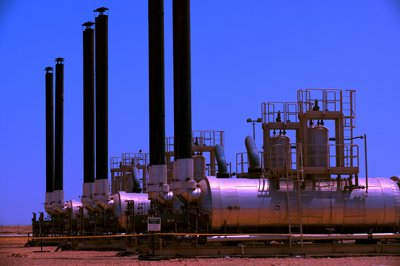
In November 2006 Petrofac was awarded a lump sum engineering, procurement and construction (EPC) contract worth $375m by the Khalda Petroleum Company (KPC) to build two new gas processing trains (SGT3 and SGT4) at the Salam facility in Egypt’s Western desert.
KPC is a joint venture company of Apache Corporation and Egyptian General Petroleum Corporation (EGPC). The project was completed in 2009 using the expertise of local construction and fabrication company Petrojet.
The scope of the project covered the execution of project management, detailed design, procurement, construction, pre-commissioning, commissioning, start-up, performance testing and initial operations. KPC added these new gas processing trains to exploit the gas produced from its new discoveries at Qasr in the Khalda Concession. Egyptian Natural Gas Holding Company (EGAS) also has interests in the project.
Salam’s gas processing trains
SGT3 and SGT4 are gas conditioning trains encompassing gas separation, mercury removal, gas dehydration, TEG regeneration, gas dew-pointing, CO2 removal, gas export compression, condensate stabilisation, condensate storage and export system, recycle gas compression, flare system, hot oil system, power generation / distribution and all associated tie-ins with the existing plant. A related pipeline compression project was also completed.
The total capacity of the facility with the two new trains and the pipeline project is 600 million cubic feet (mcf) of gas and 5,000 barrels of condensate a day from the Qasr field. The project uses processing capacity at the Shell Obaiyed plant.
Current gross production from Apache’s Jurassic fields is 512mcf of gas and 18,200 barrels of condensate per day, the limit of existing processing facilities. Apache’s current net production from the fields is 290mcf of gas and 8,000 barrels of liquid hydrocarbons a day.
The new processing capacity was sorely needed. Each of the new trains have the capacity to process 100mcf of sales gas and 14,000 barrels of sales condensate a day. With the potential of the Qasr discovery there may need to be two more gas processing trains by 2012.
Apache reserves in the Qasr field
Apache Corporation has determined that the Egyptian Qasr-2X well has significant reserves. In 2003 tests the well flowed 34.5mcf of natural gas and 1,320 barrels of condensate a day from perforations between 12,908ft and 13,084ft in the Jurassic Lower Safa reservoir.
A production test of the Lower Safa reservoir at the base of the 707ft gross hydrocarbon column was conducted from 70ft of perforations between 13,444ft and 13,514ft through a 1in choke with 2,014lb per square inch (psi) of flowing wellhead pressure. G Steven Farris, Apache president and CEO, said: “We found more than we were looking for in the Qasr-2X.” The appraisal well, which is 1.5 miles south-west of Qasr-1X, is 31ft structurally higher with an additional 200 net feet of pay. The Qasr discovery and appraisal wells have added significantly to the hydrocarbon potential of Egypt’s Western Desert.
To fully delineate the 13,000ac, seismically defined structure, three additional appraisal wells were drilled in 2004 and one was spudded prior to 2005.
The new field is located on the Khalda concession, which Apache operates with a 100% contractor interest. The Qasr-1X discovery flowed 51.8mcf of gas and 2,688 barrels of condensate a day from 269ft of perforations in two intervals from the Lower Safa formation.
Qasr-1X is flowing approximately 10mcf of gas and 400 barrels of condensate a day at 4,135psi flowing tubing pressure on a 2 / 64in choke. The gas is delivered to Apache’s Salam gas plant via a new 6in early production sales line.
Based on the results of the two new wells, Apache estimates that the reserve potential is now in the range of one trillion to three trillion cubic feet of gas and 20 million to 70 million barrels of condensate.
An additional 62ft of pay was logged at the shallower depths of the Qasr-2X in the AEB sands. These sands produce oil in the Ozoris Field approximately 2.4 miles northeast of the Qasr-2X well.
Apache drilled the Qasr-7X well 215ft south of the Qasr-2X to exploit the AEB-3E and AEB-3D sands. The well, currently in production, tested at an initial capacity of 1,579bopd from 20ft deep perforations in the AEB-3D sands.



